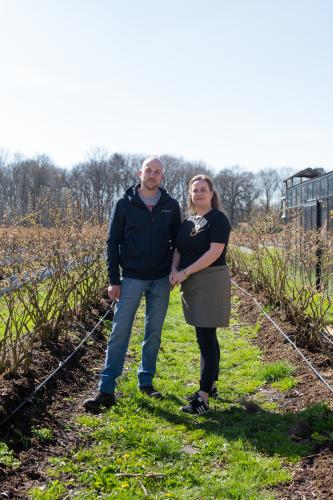“The plantation has existed since 1969. In 1997, my parents took over the plantation from the Strents family and further expanded it. We have switched back to organic cultivation. It takes three years to become a fully organic business and earn the certification. Still, we are taking on the challenge and continue to take steps in making the business more sustainable. We see the transition to organic farming happening all over the Netherlands. There is actually no space left for conventional agriculture in the Netherlands. In the future, we hope to increasingly enter into harmonious collaborations with farmers, recreation, and nature, where everyone has the right to existence and development. I think that is a beautiful goal, and that everyone can strengthen each other. In this way, one plus one makes three!”
The hospitality area later became a nice addition to the blueberry plantation, allowing the plantation to further distinguish itself. Laura: "In the peak season, people come to pick blueberries and have a cup of coffee, or they come for a drink and then take some blueberries home. You get a lot of vacationers then. What you see in winter are the people who remain and come three times a week for a cappuccino. Sometimes people sit together and make arrangements. That's what I love about hospitality work, it connects people! During the COVID-19 pandemic, the social aspect disappeared, and that was sometimes really hard for a lot of guests. In a village, you do have a role in bringing people together."

Birdwatchers
"A few years ago, there was a special little bird in the area, which attracted a lot of birdwatchers. That bird knew exactly when the hospitality rush was. In the morning, it flew away and returned in the evening when all the guests had left. If you can say that your hospitality venue is located in a national park, that is really something special. At the same time, the story from the agricultural side is a bit more challenging. Nature and farmers always seem to be at odds, but I think they can coexist quite well. That's why my brother and I like to think along with developments, but it also needs to remain advantageous for us."
When we first went walking in Roermond East, it really felt like another world, as if we had been driving for hours to another country. It was colorful, still quite rough because it had only recently been laid out. When people ask me where it's nice to walk, I often talk about Roermond East. I also hope that the connection between Boukoul and that area improves so that it's easier to get there. That area is really a hidden gem and, of course, a lot can still be developed there.”
Since the corona era, many have discovered nature. That has led to a lot of crowds in nature areas, De Meinweg being no exception. Laura: “I'm also part of a club called ‘Area Development Roermond East’. We are committed to improving and making that connection more attractive. Often you go walking in the Swalmdal or in the Meinweg, it would be nice if the area behind Asenray also gets the appreciation it deserves. By developing Roermond East a bit more, you could spread those visitors more over other nature areas. For walkers, there would be more variation possible and it would be less crowded. This way, nature is also less burdened. As far as I'm concerned, that's a win-win situation!
What has stuck with me in a broader sense is the development of the area in terms of recreation. Sometimes you wonder where such a process leads, but if you now see how many people use walking and cycling routes and how much connection this creates between villages and areas, I think the municipality of Roermond has done well here. The walking routes were chosen by people who know where the beautiful spots are.